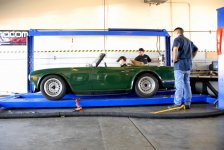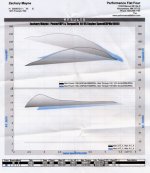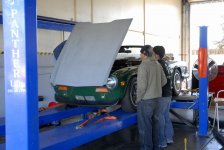Hey everyone,
Recently had my TR6's engine tested on a chassis dyno. Results were pretty good, though I'm surprised at the disarity between the horsepower and torque. As you can see, peak hp was 104.3 at 4150 rpm and peak torque was 147.8 ft-lbs at 2750 rpm. With the parasitic loss from the driveline that works out to maybe 120 hp and 165-170 lb/ft of torque at the engine, which is a loose guess.
I am very happy with the torque figure, but the horsepower figure was a bit lower than expected.
This is a freshly built motor that has not really been setup yet. Carbs are as I bought them, with the exception of different emulsion tubes. Its still running the points setup since the Crane I had installed gave me problems. I'll be going with a Pertronix soon.
Here's was the motor has so far:
.060 overbore pistons
10:1 c/r
Medium fast road cam (can't remember the specs right now)
big valves, h/d valve springs, h/d lifters
ported and polished head
cannon intake
triple Weber carbs
air horns (for dyno)
Monza header
1.75-inch exhaust with two resonators, no muffler
stock ignition and distributor
lightened stock flywheel
Future additions:
Roller rockers
Pertronix
3-inch exhaust
Mallory distributor
and more...
How do these dyno numbers look?
Recently had my TR6's engine tested on a chassis dyno. Results were pretty good, though I'm surprised at the disarity between the horsepower and torque. As you can see, peak hp was 104.3 at 4150 rpm and peak torque was 147.8 ft-lbs at 2750 rpm. With the parasitic loss from the driveline that works out to maybe 120 hp and 165-170 lb/ft of torque at the engine, which is a loose guess.
I am very happy with the torque figure, but the horsepower figure was a bit lower than expected.
This is a freshly built motor that has not really been setup yet. Carbs are as I bought them, with the exception of different emulsion tubes. Its still running the points setup since the Crane I had installed gave me problems. I'll be going with a Pertronix soon.
Here's was the motor has so far:
.060 overbore pistons
10:1 c/r
Medium fast road cam (can't remember the specs right now)
big valves, h/d valve springs, h/d lifters
ported and polished head
cannon intake
triple Weber carbs
air horns (for dyno)
Monza header
1.75-inch exhaust with two resonators, no muffler
stock ignition and distributor
lightened stock flywheel
Future additions:
Roller rockers
Pertronix
3-inch exhaust
Mallory distributor
and more...
How do these dyno numbers look?

 Hi Guest!
Hi Guest!

 smilie in place of the real @
smilie in place of the real @
 Pretty Please - add it to our Events forum(s) and add to the calendar! >>
Pretty Please - add it to our Events forum(s) and add to the calendar! >> 


